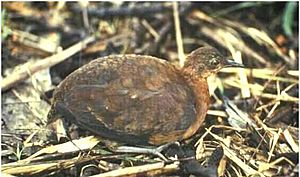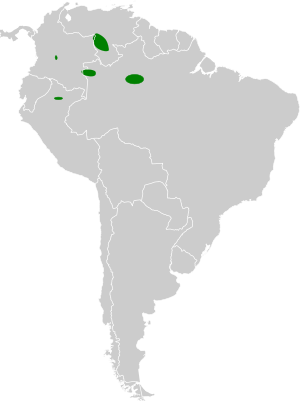Grey-legged tinamou facts for kids
Quick facts for kids Grey-legged tinamou |
|
|---|---|
 |
|
| Conservation status | |
| Scientific classification | |
| Genus: |
Crypturellus
|
| Species: |
duidae
|
 |
|
The grey-legged tinamou (Crypturellus duidae) is a small bird that lives on the ground in parts of South America. It's quite hard to spot because it's small and likes to stay hidden. This bird is special because it's part of a group called tinamous, which are related to large flightless birds like ostriches and emus.
Contents
About the Grey-legged Tinamou
What's in a Name?
The grey-legged tinamou was first described by a scientist named John T. Zimmer in 1938. Like all tinamous, it belongs to the bird family called Tinamidae.
The scientific name for its group, Crypturellus, has a cool meaning. It comes from old Latin and Greek words:
- Kruptis means 'covered' or 'hidden'.
- Oura means 'tail'.
- Ellus means 'small'.
So, Crypturellus means 'small hidden tail'. This fits the bird well because it's small and likes to hide!
There are 21 different species in the Crypturellus group. All of them are tinamous found in South America. The grey-legged tinamou is a monotypic species. This means it doesn't have any different types or subspecies within its own group.
Are Tinamous Related to Ostriches?
Scientists have long debated if tinamous are part of the ratite group. Ratites are large birds that cannot fly, like ostrichs, kiwis, and emus.
For a long time, tinamous were thought to be separate from ratites because tinamous can fly, even if they are not very good at it. However, some recent genetic studies suggest that tinamous might be close relatives of extinct birds called moas, which were also ratites. This idea means that different ratite birds might have lost the ability to fly at different times in history. This topic is still being studied by scientists.
What Does the Grey-legged Tinamou Look Like?
The grey-legged tinamou is a small bird that lives on the ground. It is not a strong flyer. It measures about 28 to 31 centimeters (11 to 12 inches) tall.
Here are some of its features:
- It has a rusty-colored neck and upper back.
- Its upper chest has a hint of grey.
- Its wings and body are a scaly brownish-black color.
- It has a noticeable black eye.
- Its legs are a slate grey color, which is how it got its name!
You can tell male and female grey-legged tinamous apart by their heads. Males have a dark crown of feathers on top of their heads. Females have a completely rusty-colored head. Females also have special markings on their backs and wings.
It can sometimes be confused with the variegated tinamou. However, the variegated tinamou has a fully grey head and bolder stripes on its wings and back.
Where Do They Live and What is Their Home Like?
Grey-legged tinamous live in several South American countries. These include Colombia, Peru, Ecuador, Guyana, Venezuela, and northern Brazil.
It's hard to know their exact numbers because they are spread out in small groups. They prefer to live in dry shrubland, usually below 500 meters (1,640 feet) in altitude.
These birds are good at living in special places called Amazonian white-sand forests. These forests have low-hanging trees and thick plants. This helps the tinamous stay hidden. They have also been seen in wet, swampy areas called peatlands.
Grey-legged Tinamou Behavior
Vocalization
The grey-legged tinamou has a unique call. It sounds like a short, hollow, two-syllable whistle. People describe it as "whoo-whoooooooo," with the sound rising slightly at the end. The call usually lasts about 2 to 3 seconds. This is the only call scientists have recorded for this bird.
You can listen to the grey-legged tinamou's call here: Grey-legged tinamou call eBird.
They call most often at dawn and dusk. They also call during the day when it's cloudy or rainy.
Diet
The grey-legged tinamou mainly eats fruits and other parts of plants. They especially like to eat fruit that hangs low or has fallen to the ground. Like all tinamous, they search for food on the ground and in low bushes. They have also been seen eating insects and other small creatures that live on the ground.
Reproduction
There isn't much information specifically about how grey-legged tinamous reproduce. However, most tinamou species build their nests on the ground. They often choose to nest in small dips or hollows near the large, wide buttress roots of trees.
Conservation Status
In 2020, the IUCN (International Union for Conservation of Nature) listed the grey-legged tinamou as a species of Least Concern. This means they are not currently in great danger of disappearing.
However, some people have suggested that their status should be reclassified. This is because the number of these birds has gone down in some areas over the last two years. The main reasons for this decline are:
- Deforestation: Forests where they live are being cut down.
- Hunting: They are also threatened by hunting in their habitats.
The areas where grey-legged tinamous are found are changing a lot because of human activities. Because they are spread out over a large area, it has been hard to do a full survey of their populations everywhere they live.
See also
 In Spanish: Tinamú patigrís para niños
In Spanish: Tinamú patigrís para niños


